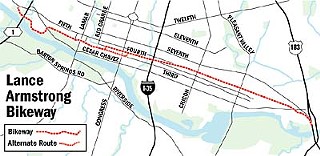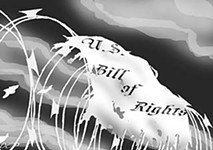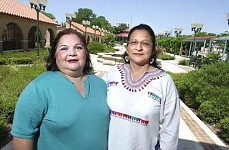Bikes on a Road to Nowhere?
By Lauri Apple, Fri., May 23, 2003
It takes a lot more than just a paintbrush to install a bicycle lane. Like many other city projects, local bicycling initiatives typically involve planning gridlock between city staff, City Council, and the community, which on occasion stalls projects for years on end. As the following examples show, communication breakdowns between involved parties can derail projects of all shapes and sizes:
Lance Armstrong Bikeway
Some cycling advocates will be at City Council today (Thursday) to advocate approval of a bikeway-related engineering-and-design contract with transportation consultants Wilbur Smith and Associates. Other cyclists will stay at home and scowl, dissatisfied with plans for the bikeway.
Originally proposed to the city by cyclist Eric Anderson in 1999, the 6-mile, east-west route will run from U.S. 183 in East Austin to Deep Eddy Pool west of MoPac, with funding coming from the feds ($2 million) and the city ($1.2 million). Currently in design are the sections west of Shoal Creek and east of I-35, with groundbreaking expected in late 2004. Public Works is trying to finish the bikeway segment running under I-35 at Fourth Street under a separate contract controlled by the Texas Dept. of Transportation. The last major council action on the bikeway occurred Feb. 27, when members unanimously voted to route the bikeway along Fourth Street through the Warehouse District. Council's decision to support TPSD's recommendation pleased cyclists concerned about safety and aesthetics but angered Warehouse District businesses who wanted the bikeway routed on Third to preserve scarce parking spaces.
On whatever route, some cycling advocates, including members of the Urban Transportation Commission, believe the bikeway's current design is less than world-class. Plans call for building a hike-and-bike trail west of Shoal Creek running parallel to an existing trail, but one East Austin segment won't even have a painted lane; it will be distinguished only by green signs. The UTC voted in February not to endorse the bikeway as currently designed, but members took up the issue again at their meeting earlier this week and decided to support the staff plan. "Something is better than nothing," says Commissioner Tommy Eden.
TPSD staff says the city doesn't have enough money to purchase new right-of-way, so it is using the only pieces of land and roadway currently available for the bikeway. "Bicyclists are so used to having nothing that they tend to dream pretty big and think in bicycle-utopia terms," says TPSD bike/pedestrian coordinator Linda DuPriest. "But after four years, we're always going to have to accept less-than-perfect facilities. It's better to just get something on the ground and get more people riding."
Guadalupe/Lavaca Bike Lanes
The Austin Bicycle Plan, adopted in 1996, calls for bike lanes on Guadalupe and Lavaca, Downtown's two major north-south routes. Momentum to actually install these lanes picked up last December after 36-year-old activist Keith Vick was killed by a truck at the corner of 10th and Lavaca, in front of the Travis Co. Courthouse.
Yet city staff and Council Member (and cyclist) Daryl Slusher assert that lanes on Guadalupe and Lavaca would be too expensive to justify, particularly when there are quieter, safer routes nearby (like Nueces and San Antonio), and when streets outside Downtown go lacking of bike lanes and safety amenities. Furthermore, a bike lane on Guadalupe or Lavaca would require removing either a travel lane or a number of metered parking spaces.
Cycling advocates who call for zero tolerance of bike-unfriendly city streets disagreed strongly with staff and Slusher. Some, including Urban Transportation Commissioner Tommy Eden (who chairs the UTC's bicycle subcommittee), investigated the feasibility of bike lanes on their own. Recently, Eden took his research to council members Jackie Goodman and Danny Thomas, who initially agreed to sponsor an item this month directing TPSD to pursue lower-cost options for the bike lanes.
But now Eden and other cyclists have changed course and are now advocating that the city explore "sharrows" -- pseudo-lanes indicated by pavement markings and road signs reminding motorists to "share the road" with two-wheeled citizens. Sharrows have been implemented in Denver as well as in North Carolina.
Shoal Creek Boulevard
When looking for a poster child to illustrate the communication meltdowns that hamper city transportation efforts, many people point to the Shoal Creek Boulevard resurfacing project, now in its third year. Mayor Pro Tem Jackie Goodman says the project, which involves installing a bicycle lane on Shoal Creek between Foster Lane and 38th Street, may finally be implemented but that available funds might be insufficient. "We'll see," she says.
In the project's early stages, neighborhood residents worried about losing parking space on one side of the street, which would have prevented them from parking in front of their houses. Bicyclists wanted the city to abide by the Austin Bicycle Plan, which calls for the lane. Goodman's input, combined with planning guidance from local bicyclist and transportation consultant Charles Gandy, helped bicyclists and neighborhood residents reach a solid truce.
Both sides, as well as the UTC, backed Gandy's plan calling for 6 feet of parking space along one side of the road, next to a painted 4-foot bike lane. But TPSD staff deemed Gandy's plan too dangerous for cyclists squeezed between parked and moving cars and insisted on adhering to national highway standards (which call for parking lanes to be at least 7 feet wide) while providing their own alternative: a 10-foot multiuse shoulder for both cyclists and parked cars. "Gandy probably vowed never to take a job in Austin again after this experience," said one participant.
Last week residents of Allandale, one of two neighborhoods that participated in the Shoal Creek planning process (the other was Rosedale), were stunned to find out that the city is planning to install a traffic light at 45th and Shoal Creek in two weeks. Traffic signals can trump traffic-calming efforts as impatient motorists try to speed through yellow lights, endangering bicyclists and pedestrians. Neighborhood leaders say no one mentioned the light at a meeting city staff held last week on Shoal Creek, which was nonetheless "productive."
Got something to say on the subject? Send a letter to the editor.









